We make shoes for the dog with our own hands - patterns and explanations for them. How is a dog's paw different from a cat's paw?
1. The structure of dog paws
Paw of a 4 week old puppy.
2. The pads of the feet act as shock absorbers and protect the bones and joints of the limb. The wrist pad acts as a kind of brake and helps the dog navigate slippery or steep slopes. Dogs' paw pads contain a lot of connective tissue and fat, which have poor thermal conductivity.
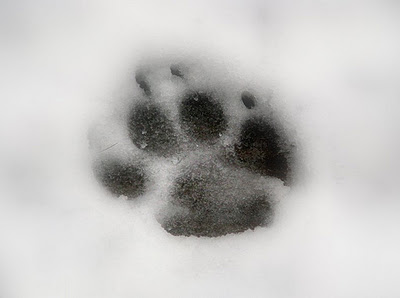
3. Dogs stay warm on cold ground thanks to a unique circulatory system in their paws. Arctic foxes and wolves are known for their ability to withstand cold temperatures. Previous studies have shown that dogs can retain heat in their paws even at -35°C. Dr. Hiroyoshi Ninomiya and his team from Yamazaki Gakuen University (Tokyo) discovered that the arteries in the paw pads, located in close proximity to the veins, warm the blood flowing back to the heart. Therefore, when the blood is cooled by contact with cold ground or snow, heat is transferred from nearby arteries, warming the blood before returning to the body, thus helping to reduce heat loss and maintaining a constant temperature in the paws. A similar mechanism was found in penguins in the beak and in dolphins in the fins. In addition, Dr. Arnaud Tarroux from the University of Quebec (Canada) discovered a “remarkable network” of veins in the paws of dogs that act as a heat exchanger in which cooled blood is heated to maintain a constant temperature.
4. Paw pads also protect the dog's feet when moving over rough terrain. Dogs that exercise a lot outside have thicker, rougher, and rougher skin on their paw pads. Sedentary dogs and couch potatoes have thinner skin, which can be easily injured.
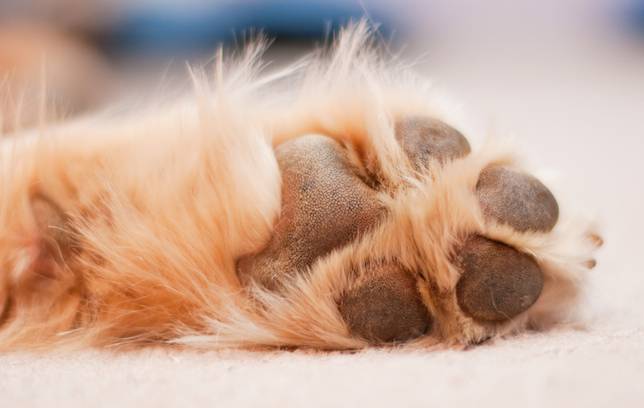
5. Inner surface Dogs' paws have developed sweat glands that help cool their paws. These glands are also involved in marking territory and producing alarm pheromones. When marking territory, dogs often scratch the ground with their claws, thus leaving marks with gland secretions. It is likely that anxiety pheromones are produced during stressful situations (for example, visiting a veterinary clinic), while dogs leave wet marks with their paws, which can “transmit” the fear reaction to other animals.
6. Dogs are digitigrade animals, which means their toes, not their heels, do the walking. most load of their body weight when walking.
7. Dogs cannot move their fingers like we can.
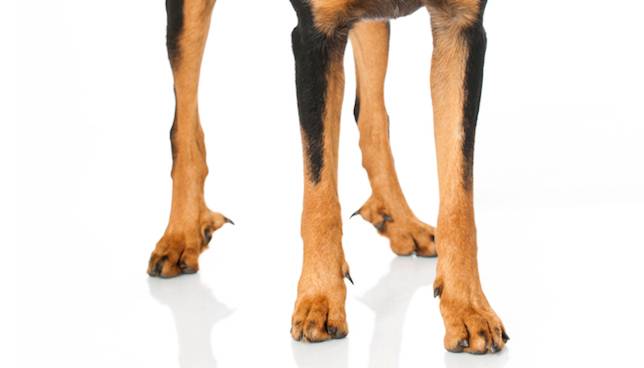
8. Some dogs have dewclaws on their hind legs. In some breeds (for example, Baseron, Briard and Great Pyrenees) they are fixed by the standard. The posterior vestigial finger often lacks the first or second phalanx and is attached only to the skin. It is believed that dewclaws contribute to better grip on the ground, but they can be injured, so in many breeds they are removed in puppies at the age of several days.
9. Some dogs have webbed feet. Most often they can be found in Labradors, Newfoundlands and other water dogs, as well as in northern breeds (Siberian Husky, Malamute).
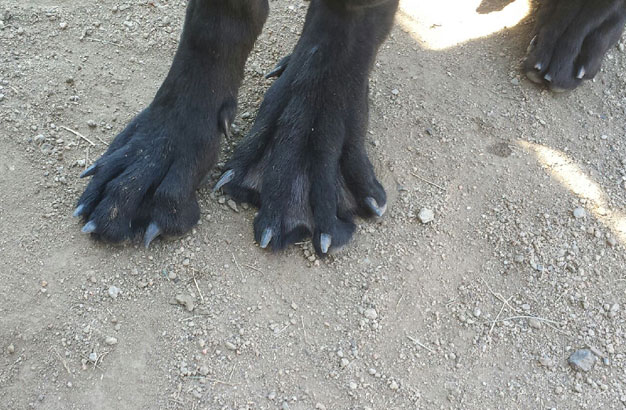
10. A number of dog breeds have the so-called “cat paw”; this paw structure allows you to spend less energy and increases the dog’s endurance. Cat paw prints are round and compact. Akita, Doberman Pinscher, Giant Schnauzer, Airedale Terrier, Finnish Spitz and other breeds have such paws.
Paw care Taking care of a small dog is just as important as other health care tasks. By nature, small dogs do not have any protection for their paws, but they must walk, run, and jump on concrete, asphalt, ice, snow, and rocky surfaces. Their paws are constantly exposed to various, potentially dangerous conditions. Not surprisingly, paw injuries in small dogs are quite common.
Possible causes of injury
As you can imagine, there are many ways that can lead to injury to your little dog's paws. The most common are:
- Cuts on the pads of a small dog's paws caused by sharp objects
- Cracks in dog paw pads due to hot, dry or cold weather
- Insect bites and stings
- Broken claws
- Dislocated fingers
- Foreign objects (such as small stones, burrs, etc.) between the fingers
Signs of injury
Signs and symptoms of paw injuries in small dogs depend on the cause. The most common:
- Lameness
- Reluctance to use injured paw, tucking
- Biting or licking the affected paw
- Whining
- Swelling, redness, pain, itching (in case of insect bites and stings)
- Inflammation or infection caused by foreign objects stuck between the fingers
- Swollen and painful paws (in cases of a broken or dislocated toe)
Natural Home Remedies for Paws
With the exception of deep cuts and broken bones, most small dog paw injuries are fairly minor and can be treated at home. Natural remedies such as herbs, vitamins and minerals are very effective in treating dog paw injuries and keeping them healthy.
Vitamin E for cracked paw pads
If your dog has cracks or scratches on his paw pads, try giving him a Vitamin E supplement. Vitamin E improves blood circulation, which leads to faster healing of cracks and scratches. Vitamin E also strengthens the immune system and is therefore effective in preventing infections.
Zinc/Selenium against cracked paw pads
These elements are indispensable when we're talking about about maintaining healthy skin and paws. Zinc strengthens the skin and speeds up healing, while selenium improves immunity. Consult your veterinarian regarding the optimal dose for your dog.
Caring for the health of your dog's paws
Claws
A dog's nails that grow very long without regular trimming can cause harm to the dog. One of the results of uncontrolled nail growth can be ingrown nails, which in most cases causes very painful sensations for the dog. Overgrown claws can also break easily. In addition, long claws make it difficult for the dog to move, during which its weight is redistributed from the heel to the toes. As a result, a dog with long nails may develop pain in its paws and hips. Therefore, it is important to trim nails regularly.
Many dogs don't like having their nails trimmed. It is easy to take too much and cut close to blood vessels and nerve endings, which will lead to bleeding. This causes a lot of pain and it is not surprising that dogs almost always resist when they see a nail clipper!
An alternative to a nail clipper is an electric nail sharpener, which allows you to quickly and accurately grind nails down to the right size without causing pain to the dog.
Tip #1: If you're using a nail clipper and accidentally cut off too much and don't have anything on hand to stop the bleeding, you can use cornstarch for this purpose. (if you know another way to stop bleeding using improvised means, write in the comments)
Tip #2: After trimming, apply some Vaseline to the nails and buff them with a soft cloth to keep them looking shiny and clean.
Paw pads
Your dog's paw pads may be dry and rough during the winter, especially if you live in an area where it is cold and snowy.
Rock salt and most chemicals used to de-ice ice can irritate your dog's paws. Salt and deicers stuck between your dog's toes can cause discomfort when walking. Most anti-icing materials and rock salt also toxic to dogs if ingested.
Therefore, it is important to pay special attention paw care in winter. In particular:
- As much as possible, stay away from areas heavily sprinkled with salt and reagents.
- Check your dog's paws after a walk. In particular, look between your fingers to see if anything is stuck, and examine the pads for cracks.
- To avoid salt or de-icers getting into your dog's stomach, always wash your paws warm water after winter walks and activities.
- Apply the balm to your dog's paw pads after washing to prevent drying and cracking.
- Use safe de-icers around your home.
- If you are going on a winter hike, protect your dog's paws from snow. Train your dog to wear shoes. If she categorically refuses boots, then it would be advisable to use special gels and sprays to protect her paws from snow, ice and toxins.
Dogs are among man's oldest friends and helpers and are very loyal creatures that... last day love their owner no matter what. That is why, with diseases that can affect a dog, a good owner will do everything possible to cure his animal. There are a considerable number of different diseases that can affect dogs, among them limb injuries occupy a special place.
The dog is characterized by increased activity almost throughout its entire life, which naturally leads to frequent mechanical injuries and damage. Most often, owners do not pay close attention to small wounds or minor injuries to their pet, since the dog’s body has the ability to heal wounds very quickly and resist infections. But sometimes there are cases when the proverb “heals like a dog” does not work and long and complex treatment has to be carried out, sometimes even in a clinic.
How can you tell if your dog has problems with its paws?
It is quite easy to independently diagnose problems with limbs in a dog, since all 4 paws are involved in movement. There are four main signs that indicate problems with your pet's limbs:
- Appearance of lameness.
- The dog tries to rely on the remaining three limbs, in cases where the problem affects only one paw.
- When palpating the damaged limb, the dog becomes restless, whines and howls.
- The pet's movements are very cautious, with manifestations of fear of taking a new step.
At the first manifestation of at least one sign, it is recommended not to waste time and try Take your dog to the vet as soon as possible, since there are several types of damage that can lead to tissue necrosis and subsequent death.
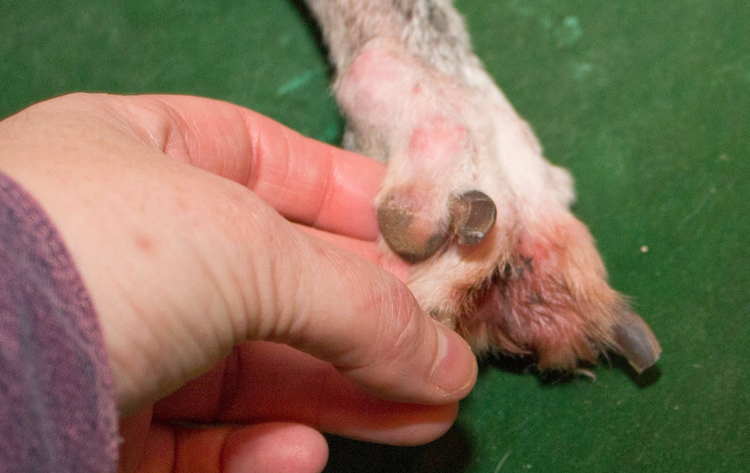
Causes of rotting paws in dogs
There is a misconception that there are few reasons that can cause injury to dog paws and further suppuration, but in fact there are a great many of them. First of all, the presence of an inflammatory disease can cause purulent inflammation, or a combination of various factors can lead to damage to the paw, which will cause infection and subsequent suppuration.
It is customary to identify three main reasons:
- Mechanical damage to the paw pads.
- Fungal diseases.
- Allergic reactions.
Mechanical damage to the dog’s limbs, which can cause purulent wounds
Despite the presence of fairly hard pads on the paws, between them, or rather between the toes, Dog skin is very delicate and any damage to this area can trigger an inflammatory process. Inflammation of the dog's toe area can occur as a result of ordinary bruises. Another reason, which is a catalyst for the inflammatory process that ultimately results in suppuration, is constant walking on a hard surface in the form of asphalt or a paved road. Still, the dog needs to run on soft soil or grass.
Another reason that can be attributed to mechanical is hypothermia of dog paws. During a long stay in the cold, and in in this case It is the pads that are damaged. The process of frostbite itself occurs due to the mobilization of the body to preserve vital functions, which leads to maximum narrowing of the lumen of blood vessels. When frostbite occurs on the paws, normal cell death occurs, which is accompanied by tissue necrosis, which ultimately provokes rotting.
Also common injuries that occur on dog paws are cuts. A dog, unlike a person, does not know how to look closely at objects lying on the ground and is not always able to notice shards of glass or understand that a stone in its path has sharp edges. In such cases, at the first sign that the dog begins to show discomfort when walking, you should carry out a palpation procedure yourself, which will help identify the cause.
Fungal diseases leading to rotting of the paws of a pet
The most common problem that dog owners come to the veterinary clinic with is dermatophysis or fungus However, a dog of any age and living in any living conditions can become infected with the fungus. There is practically no way to completely protect your pet from the appearance of fungus, but it is possible to use effective methods treatment thanks to a large number modern drugs.
The fungus can appear in a dog’s body when interacting with already infected individuals, or simply by walking on the grass on which the pathogen is located. Even the owner himself can bring fungus on the sole of his own shoes. One of the reasons that will serve as a catalyst for the development of fungus is the dog’s low level of immunity, which requires constant monitoring of the condition of your pet and the introduction of a sufficient amount of vitamins into the diet.

Allergic manifestations
Another cause of purulent infections is allergic problems. Many dogs are allergic to the reagents that are sprinkled on the streets in winter. Chemical composition, which is an irritant, affects the soft skin between the dog's toe pads, especially when salt and reagents mixed with it become lodged in this area.
Prevent similar allergic reactions very simple. In winter, after each walk, it is recommended to simply rinse the paws thoroughly to remove any remaining salt, reagent, or just dirt, which may also contain particles of chemically aggressive compounds.
How to overcome rot on your dog's paws
In order to prevent serious problems with the limbs of a pet, you should very carefully monitor its behavior and the slightest changes associated with walking or running. If a problem is noticed in time, it will allow you to quickly provide the help you need and prevent the development of purulent inflammation.
If the presence of pus or significant redness is already observed, it is necessary to immediately take the dog to a veterinary hospital, where the doctor will be able to make the correct diagnosis and prescribe the necessary treatment. Most often, in advanced cases, antibiotics and strong ointments are used to completely get rid of the problem.
You should definitely wash your dog’s paws after going outside, even if you don’t consider yourself a clean person. This procedure is needed not only to maintain order in the house. In winter, paws are exposed to reagents that are sprinkled on ice, and in the warm season, the dog can step into gasoline, motor oil, or chemicals of unknown origin.
If you do not wash your paws from caustic substances in time, this can lead to burns or skin irritation. In addition, the animal can lick its paws and become poisoned. You should wash your paws more thoroughly than usual after visiting the veterinary clinic. On their paws, pets bring pathogenic bacteria and worm eggs into the house. Without paying due attention to paw hygiene, you risk harming the health of not only your pet, but also family members, as well as other pets, if you have them.
Let's figure out what and how to wash your dog's paws to avoid trouble, as well as make washing quick and comfortable.
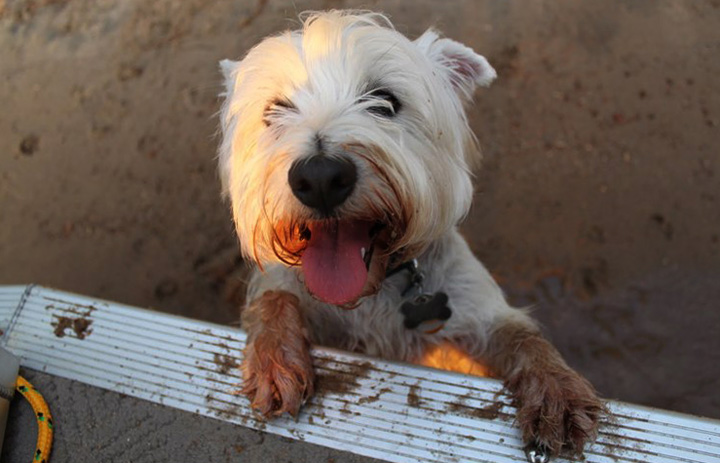
What you might need to wash your paws
To keep your pet's paws clean and healthy, it is advisable to purchase the following items:
- Basin with water. It is placed either near front door, or in the bathroom. If you are washing your dog in the bathtub and are concerned about clogging the drain with dirt and debris, you can place a basin or baby bath directly in the bathtub. After washing, flush the water into the toilet.
- Anti-slip bath mat. It is especially important when the dog is accustomed to jumping out of the bath on its own after washing - at this moment it is easy to slip and get bruised.
- Dog shampoo or paw soap. Buy these products only in specialized stores and do not use human ones. Shampoo or special soap can be diluted in water, or you can apply it to a sponge and wipe the dog’s paws with this sponge. Don't get too carried away with detergents. Use them on heavily soiled areas rather than on an ongoing basis as they can dry out the skin.
- Cotton towel Yes, or better yet two. One is to put a wet dog on it, and the second is to wipe it off.
- Microfiber cloths. They are good for removing small dirt. They absorb water well, dry quickly, and do not leave lint.
- Wet wipes– they can be used after a walk in dry weather.
- Tar soap– useful if there are wounds or abrasions on the paws. It relieves inflammation and disinfects, and also accelerates the skin restoration process.
- Tweezers– in case there is debris clogged between the fingers or under the claws (pebbles, pieces of glass, etc.).
- Autogel for hand washing. Gasoline and other automotive fluids cannot always be washed with soap, so it doesn’t hurt to purchase one just in case. special gel. It removes fuel oil, oils, grease, and rust. It is unknown how a dog's skin will react to it, so only use this product when all else fails.
Washing paws after a walk
Now let's move on to the washing procedure itself. In dry weather you can do without it - it will be enough wipe paws with a damp cloth or napkin.
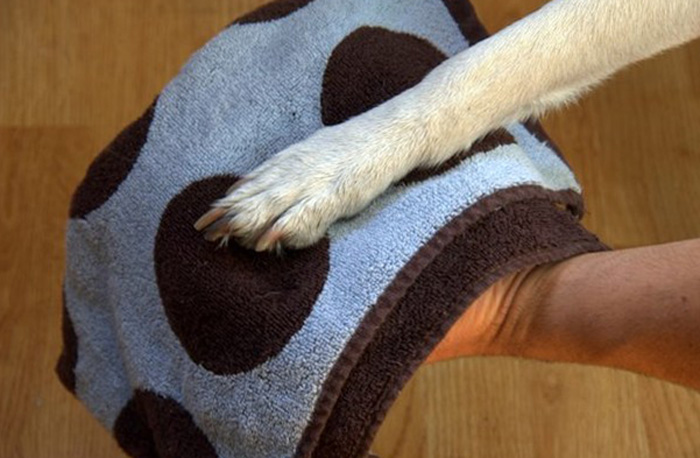
When the street is dirty, you can place a basin of water at the entrance to the apartment. First, wash your pet’s front paws in a basin, then place them on a towel and dry them, then wash them hind legs. Wipe your stomach with a rag. If the dog is not yet accustomed to this procedure and tries to run away, you can attach the leash to the handle of the front door.
![]()
During periods when spring and autumn slush reigns in the yard, not only a rag, but also a basin of water will be powerless. You can't do this without a bath. Check the temperature of the water you use to wash your dog's paws - it should be a little cooler than for washing human hands.
If the dog is small, the easiest way is to carry it into the bathroom in your arms, put it in the sink and wash each paw in turn. To prevent a large dog from dirtying the floor on the way to the bathroom, you will have to cover it with something.
When you have finished washing, inspect the paw pads and the space between the toes. Is everything clean, everything okay? Now you can wipe your paws dry and let your pet go in peace.
You can make your life easier if you walk your dog in overalls in very dirty weather. Wash your pet without removing the overalls - dirt comes off much easier from it than from fur. Another option is special dog shoes, but not all animals wear them patiently.
How to train a dog to wash its paws after a walk
All yours good intentions cleaning routines will not lead to anything if the dog resists washing. Some pets even refuse to go home because they don’t want to wash themselves!
You need to start teaching your dog good hygiene as early as possible. This is stressful for the animal, although most dogs are not afraid of water and have a positive attitude towards bathing. You should not immediately drag the puppy into the bathtub and pour water on it - teach him to wash gradually and patiently.
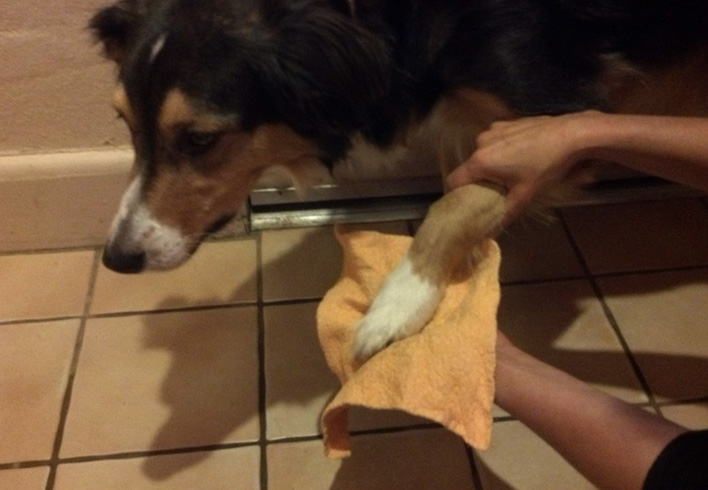
Hold your puppy's paws often so that he gets used to being touched and won't resist being washed in the future. After some time, connect napkins or a towel - wipe the puppy’s paws one by one and treat him with a treat. A clear “wash-treat” connection should be fixed in his head. When this happens, you can move on to a larger scale wash. Many dogs enthusiastically run to wash themselves and jump on the towel to get a reward.
At first, the washing procedure should be quick.. Don't worry if things don't work out at first. The dog should only have positive associations with washing, and by shouting and threatening you will forever discourage him from wanting to wash.
By paying attention to the cleanliness of your dog's paws, you will avoid many troubles with his health. Skin irritation, poisoning, unnoticed injuries to paw pads - all this will not affect your pet if you thoroughly clean its paws after every walk.
Dog paw pads require special care
There is no hair on the dog's paw pads. Except that in representatives of long-haired breeds it can grow between the toes, while short-haired representatives of the canine world are completely deprived of fur in this area. Due to the fact that the dog moves on its paws and the surface of the pads is constantly in contact with various surfaces, sometimes cracks and swellings form on the pads, and the dog can even begin to.
In order to prevent all this, we decided to talk to you about How to properly care for the skin of your dog's paws. Do I need to use any special products, and will the shoes protect the dog’s paws?
Does dog paw skin need care?
Quite often you can hear a question from dog owners about Do you need to take extra care of your dog's paw skin?. Some consider such care unnecessary, citing the fact that street dogs are deprived of such care and this does not stop them from running, jumping, frolicking... And no one takes special care of the skin on their paws. But, pets are more pampered and capricious. This should not be forgotten. Plus, when you brought this little bundle of joy into your home (remember the arguments), you took on the responsibility of caring for him. Including caring for the skin of your paws. And now your task is to:
- Monitor the cleanliness and hygiene of your pet’s paws (find out).
- Do not allow the skin on the pads to become rough.
- Prevent the appearance of cracks and swelling on the paws.
- Avoid discomfort and pain when the dog begins to limp in pain.
One of the symptoms that you need to pay special attention to the condition of a dog’s paws is a symptom when the dog begins to lick its paws often and for a long time. This is not at all connected with the desire to be cleaner, but with the fact that the dog is in pain and unpleasant. In this case, be sure to pay attention to the condition of her paws.
Dog skin and paw care products
A healthy, elastic surface of the paw pads helps the dog stand more steadily and better feel the features of the surface on which it moves. Since the skin in this area is constantly subject to friction, care must be taken to ensure that the paw pads are in order and well-groomed. To do this, the owner may need the following tools:
- Nail clipper – be sure to trim your dog’s nails. Since a long claw length can cause discomfort to the dog and injure the paw pads.
- Creams and special wax - their composition should be such that the products can guarantee protection and hydration to the skin on the paws.
- Antibacterial spray - will be needed if it is necessary to treat the surface of the pads.
- Ordinary baby soap– it should be used when you wash your dog’s paws after a walk. By the way, you shouldn’t skip such an important procedure as washing your paws, even if it seems to you that the street is clean and dry.
So you have a whole arsenal special means and items for caring for the skin of dog paws. Don't be lazy to use it. As every day, every time after a walk, inspect the surface of the pads for the presence of possible wounds, cracks or cuts. These wounds must be treated with an antibacterial agent and must be shown to a veterinarian.
If the pads are safe and sound, just wash your paws with baby soap in warm water, dry the area between your fingers well and then lubricate the skin with cream. Under no circumstances should calluses or hard areas be allowed to appear.
Before you go for a walk, you should also lubricate your paws with a protective agent - special wax.




